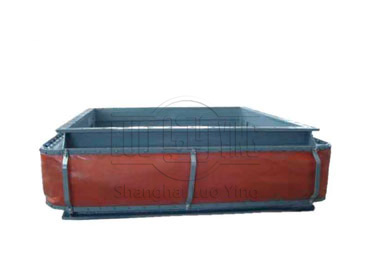Fatigue testing of non-metallic compensators.
Aug-22-23
Fatigue life design by non-metallic compensator failure type and cause analysis can be seen, the bellows plane stability, circumferential stability and corrosion resistance are related to its displacement that is fatigue life. Too low fatigue life will lead to the bellows stability and corrosion resistance performance decline. According to the test and use experience, the fatigue life of corrugated pipe for heating engineering should be not less than 1000 times. Corrugated pipe can not bear the weight, should be suspended separately; in addition to the design requirements of pre-stretching or cold tight pre-deformation amount, it is strictly prohibited to use the method of deformation of the corrugated pipe to adjust the installation deviation of the pipe; installation process does not allow the welding slag splash to the surface of the corrugated pipe and other mechanical damage; corrugated pipe all active components shall not be external components stuck or limit the normal work of its active parts.Non-metallic compensator first of all to constitute the compensator of the flexible parts of the bellows characteristics, because the performance of the bellows determines the performance of the compensator. Here we introduce what factors need to be considered in the design of non-metallic compensator. 1、Strength. Non-metallic compensator is balanced in the radial direction when it is subjected to internal pressure, while the axial direction is unbalanced. Therefore, the pressure-bearing capacity of the non-metallic compensator should be a comprehensive trade-off between the strength and stability of the bellows. To improve the pressure-bearing capacity of the non-metallic compensator, to prevent the internal pressure caused by the lateral deformation of the bellows, can be used to strengthen the ring or multi-layer bellows approach, bearing high pressure bellows with mechanical braking method to limit the stroke to ensure that the elongation and compression of the bellows control in the normal range. 2、Stiffness. The stiffness of the bellows is the ratio of the force and the displacement caused by the action, usually expressed in K. The smaller the K value, the better the flexibility of the bellows, K value is too small, the bellows may be out of balance due to excessive deformation, and K value is too large, the bellows is difficult to meet the requirements of displacement compensation. Therefore, the stiffness is one of the indicators of the design of non-metallic compensator.
The non-metallic compensator also needs to meet the strength condition in the design, that is, its large stress does not exceed the permissible stress under the given conditions. The allowable stress can be derived from the limit stress divided by the coefficient, according to the working conditions of the non-metallic compensator and the requirements for its use, the limit stress can be the yield strength, or the critical stress when the bellows is destabilized, or the fatigue strength, etc. To calculate the bellows large working stress analysis of the stress distribution in the bellows wall. Through the above introduction believe that you have a certain understanding of the design factors of the non-metallic compensator, in the product design process to fully take into account various factors, in strict accordance with the production process for product manufacturing, to ensure the excellent quality of non-metallic compensator products, but also in the minds of the majority of customers to establish a brand image, the enterprise will continue to adhere to quality standards, impress customers with quality.


